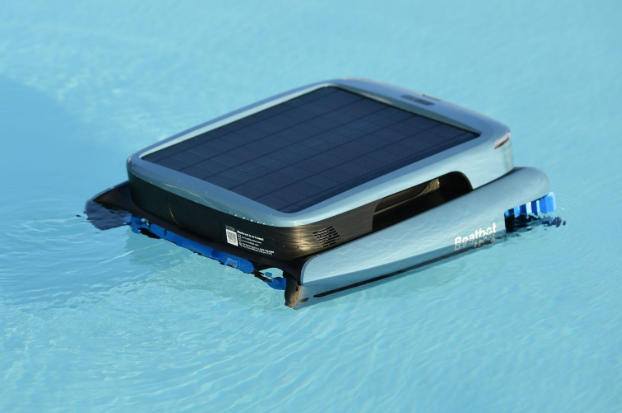If you own a pool, you may have asked: What is a pool skimmer for? The pool skimmer is an essential tool that aids the maintenance of your pool because it helps to remove the debris from the surface of the water before it sinks to the bottom. Yet, when faced with innovative cleaning tech such as robot pool cleaners, the relevance of classic skimmers is constantly challenged. This article will cover what a pool skimmer is, how it differs from new technology like robotic pool cleaners, and how these two elements can cooperate to make pool maintenance optimal.
What is a Pool Skimmer?
A swimming pool skimmer is an apparatus made particularly to grab the floating dirt on the water’s surface. These floating substances can consist of leaves, twigs, insects, and even hair and dirt. A skimmer works by sucking the surface bubbles of small leaves, insects, and trash off the water surface and filtering it so that the materials that sink to the bottom of the pool do not cause pipe clogging and water mist.
The most widely used type of pool skimmers are horizontal in front of the waterline of the pool and are connected to the pool filtration system. The debris gets caught in the skimmer basket while the filtered water is returned to the pool, and this process repeats itself, cleaning the pool water over and over. However, the pool skimmer is, in principle, simpler in concept, yet integral to the working of cleaner and safer swimming pools.
Purpose of a Pool Skimmer
High function: To clean the pool, collecting floating debris from its surface. Let us take a look at the main functions of a pool skimmer:
Surface Skimmer: The primary function of a pool skimmer is cleaning floating debris off the water surface. Without it, things like leaves, insects, and dirt can build up and settle at the bottom of the pool, where they become much more difficult to clean.
Preventing Clogs: By catching debris, pool skimmers help prevent it from entering the pool’s filtration system. Without a skimmer, small debris can eventually jam the pump or filter, which translates to slower filtering and potentially expensive repairs.
Keeping Water Clean: Removing debris before it can sink to the bottom helps keep the pool water clear and clean. The longer debris remains in the pool, the more debris can disintegrate and cloud the water.
Less Algae: Over time, decomposing leaves and organic matter can lead to algae growth in the pool. A skimmer helps to decrease the likelihood of algae by removing those materials before they decompose.
Avoid the Build-up of Debris: Leaves and other debris can accumulate in a pool over time, and cleaning them up can be cumbersome. A skimmer removes this debris before it can settle or accumulate, simplifying routine pool maintenance.
How Does a Pool Skimmer Work?
In a pool skimmer, the flow of water is used to suck in surface debris. The process works as follows:
Water Entry: Suction The Suction entry of water occurs into the skimmer through the suction opening and is usually pumped by the pool pump.
Debris Collection: The suction, draws in water along with debris into the skimmer basket, catching larger objects such as leaves and twigs.
Filtration: It filters all the water coming into the skimmer before returning it to the pool so there is no debris. Smaller particles may, however, make it through and need to be filtered further by the pool’s main filter.
Skimmer Basket Emptying: The skimmer basket needs to be emptied occasionally to ensure the skimmer continues to function. It also allows the skimmer to continue catching debris without being overloaded.
Can a Robot Pool Cleaner Replace a Pool Skimmer?
The pool skimmer is an integral part of most pool cleaning systems, but even more notable, modern robot pool cleaners raised the standards of swimming pool cleaning. An automated pool cleaner is a pool robot that can autonomously clean the pool, including its floor, walls, and waterline. Some higher-end models, such as the Beatbot AquaSense Pro, even can scoop debris from the surface, operating much like a skimmer.
Raghu RajaComparison Between Pool Skimmer and Robot Pool Cleaner
Surface cleaning: A pool skimmer specifically caters to floating debris, while a robot pool cleaner like the Beatbot AquaSense can handle floating debris as well as debris on the pool floor. Unlike a skimmer, it reaches more areas in the pool as the skimmer’s surface coverage is limited.
Filtration: A robotic pool cleaner typically has its own filtration system, which allows it to operate independently of the pool’s filtration system. This means that it will be able to deal with more minute debris such as dust or small particles, which would not usually be caught by a standard skimmer. Another great example is the Beatbot AquaSense Pro, which employs high-efficiency filters to catch tiny debris, which would otherwise lead to water quality issues.
Autonomicity: Established Robot pool cleaners are autonomic, that is they can be heaving to clean the pool minus any human intervention On the other hand, a pool skimmer needs more routine upkeep, like emptying the skimmer basket, and is typically part of a larger filtration system.
Coverage Area: The robot pool cleaner can clean the complete pool, from the floor to the waterline, while a skimmer can only remove debris from the surface. If you have a large pool or one that has its fair share of floating debris, the robot pool cleaner will save you time and make your life easier.
Advantages of Using a Skimmer & Robot Pool Cleaner
Although executing a thorough cleaning of a pool is done by a robot pool cleaner, if both a pool skimmer and a robot pool cleaner are utilized together, these will keep a clean, healthy pool. Here are a few reasons why each can be helpful:
Surface Cleanliness: The pool skimmer collects debris immediately after entering the pool so it will not submerge and be more difficult to remove later on. The rest of the pool can then be cleaned by the robot pool cleaner, which will ensure that it is aired out as well.
Less Filtration Stress: The skimmer catches larger debris, preventing it from reaching the pump and eliminating potential stress on the pool’s filtration system. The robotic pool cleaner operates independently of the filtration system, minimizing strain even more.
Overview cleaning: Though surface debris is typically handled by a skimmer, the robot pool vacuum or swimming pool robot cleaner cleans deep, including debris on the pool floor, walls, and corners.
Convenience: If you have a Robot Pool Cleaner and a skimmer working in coordination then you can achieve the best performance with minimum manual work. Skimmers collect the top debris, and the robot cleaner handles the detailed work.
Conclusion
The pool skimmer is designed to keep your pool clean by skimming debris from the surface of the water to prevent clogs and ensure water is crystal clear. Robot pool cleaners such as the Beatbot AquaSense Pro are an advanced alternative to solving the pool filtration problem, however, best results come from using both a skimmer and a robot pool cleaner. This allows you to have the surface cleaning abilities of a skimmer combined with the deep cleaning capabilities of a robotic cleaner so that your pool is always sparkling clean with minimal effort.
For pool owners who want the easiest maintenance possible, investing in both tools is a solid choice to help ensure that it’s clean and well-maintained year-round.

